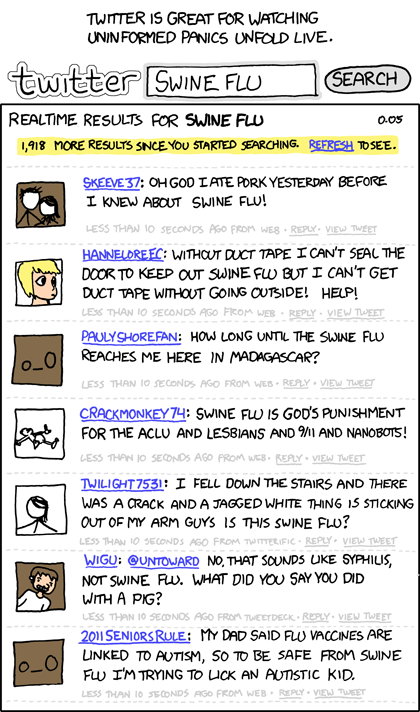Swine Flu – XKCD beat CNN to the post
So XKCD posted this yesterday ……

Now CNN made this post http://www.cnn.com/2009/TECH/04/27/swine.flu.twitter/index.html
(CNN) — The swine flu outbreak is spawning debate about how people get information during health emergencies — especially at a time when news sources are becoming less centralized.

Buzz about swine flu on Twitter is stirring conversations about how people get health news.
Some observers say Twitter — a micro-blogging site where users post 140-character messages — has become a hotbed of unnecessary hype and misinformation about the outbreak, which is thought to have claimed more than 100 lives in Mexico.
“This is a good example of why [Twitter is] headed in that wrong direction, because it’s just propagating fear amongst people as opposed to seeking actual solutions or key information,” said Brennon Slattery, a contributing writer for PC World. “The swine flu thing came really at the crux of a media revolution.”
Twitter’s popularity has exploded in recent months, and Slattery said it’s a new development that a wide number of people would turn to the site in search of information during an emergency.
Others take a softer approach to the buzz on Twitter.
Writing for CNET, a CNN partner site, Larry Magid advises online readers to take medical advice with a grain of salt.
The Internet is “a great way to get general information, prevention tips and information on how to handle a known condition, but be cautious when using it to try to diagnose yourself,”he writes.
Several dozen cases of swine flu worldwide have been confirmed by the World Health Organization and hundreds more are feared. Read more about the situation
That information needs to be put in context by journalists, especially given the fact that so many deaths from the common flu occur each year and go underreported by the news media, said Al Tompkins, who teaches broadcast and online news at the Poynter Institute, a school for journalists.
About 36,000 people die from flu-related symptoms each year in the United States, according to the Centers for Disease Control and Prevention,
The fast pace of new swine flu cases and their relevance to global public health policy makes the situation newsworthy, Tompkins said.
Tompkins said there is a tendency for television stations to hype health emergencies to boost their ratings, but so far coverage of the swine flu outbreak has been responsible. Coverage of the story is just ramping up, though, he said.
Of the swine flu news on Twitter, Tompkins said, “Bad news always travels faster than good news. I’m sure that was true in smoke signal days.”
Unofficial swine flu information on Twitter may lead people to unwise decisions, said Evgeny Morozov, a fellow at the Open Society Institute and a blogger on ForeignPolicy.com.
For example, some Twitter users told their followers to stop eating pork, he said. Health officials have not advised that precaution. Read about how the virus is transmitted
Morozov said there’s incentive for Twitter users to post whatever is on their mind because it helps them grow their online audiences.
But in an emergency, that tendency means people write about their own fears of symptoms and widespread deaths, which can create an uninformed hysteria, he said.
The debate about swine flu on Twitter is not one-sided, however. And the site is not the only place online where people are talking about the outbreak.
Some Twitter users have expressed concern that the swine flu story is being hyped. Several media outlets, including the BBC and CNN’s iReport.com, give readers and viewers a chance to express their own views about the outbreak.
The Centers for Disease Control and Prevention also maintains its own Twitter account where official government information is given straight to the public.
And on Monday, President Obama seemed to try to calm national fears by saying the outbreak is “cause for concern and requires a heightened state of alert,” but is not a “cause for alarm,” CNN reported.
Twitter traffic about swine flu has been strong. According to Nielsen Online, swine flu has worked its way into about 2 percent of all notes posted on the site on Monday. You can follow that Twitter conversation here.
Chatter about swine flu is also loud elsewhere online. About 10 times more people are writing online about swine flu than wrote about the salmonella and peanut butter scares from this winter, Nielsen says.
On Google, an interactive map lets Internet users see where outbreak deaths have been confirmed and where they are suspected. See a CNN map
Slattery, the PC World writer, said he generally was excited about Twitter until recently. Now he finds the site to be “an incredibly unreliable source of information.”
Tompkins said people who post information on social media sites should think about the credibility of their sources before they pass something on.
That’s the “online equivalent of washing your hands,” he said.
“Before you pass it on, wash your hands a little.”
And yes i did bold the “About 36,000 people die from flu-related symptoms each year in the United States, according to the Centers for Disease Control and Prevention” , as I think its fairly relevant to the panicdemic about swineflu. It only has a 4% or less hit rate. Though we have lots of ways to get it around the world really fast, we also have a LOT better ways of dealing with it and medicines and other similar things than say the previous pandemics that the world has seen.
So if I were you, i wouldnt panic just yet. Thank god its not something else, Bird flu fatality rate was 60%, SARS was 9.6% (though these figures probably vary depending on the countries socio-economic development as well as many other factors) – and they havn’t and wont rule out Bird flu, its a matter of time rather than ‘you said it was coming and it never did’.
Swine Flu Facts and Media Mongering
Much media frenzy has got 2 sides of the story going. 1 “OMG WE’RE ALL GONNA DIE!’ and the 2nd would be ‘Bah just another media bullshit story’. I think everyone should get themselves armed with facts before going either way personally, and always have at least basic provisions for a couple days stuck at home for either flu, floods, or any other general emergancy. Swine flu is NOT currently a pandemic. It spreads fast so probably could be, however the fatality rate isnt actually that high, around 4% or lower.
Heres some swineflu facts from http://www.who.int/csr/swine_flu/swine_flu_faq_26april.pdf
What is swine influenza?
Swine influenza, or “swine flu”, is a highly contagious acute respiratory disease of pigs, caused by one
of several swine influenza A viruses. Morbidity tends to be high and mortality low (1-4%). The virus
is spread among pigs by aerosols, direct and indirect contact, and asymptomatic carrier
pigs. Outbreaks in pigs occur year round, with an increased incidence in the fall and winter in
temperate zones. Many countries routinely vaccinate swine populations against swine influenza.
Swine influenza viruses are most commonly of the H1N1 subtype, but other subtypes are also
circulating in pigs (e.g., H1N2, H3N1, H3N2). Pigs can also be infected with avian influenza viruses
and human seasonal influenza viruses as well as swine influenza viruses. The H3N2 swine virus was
thought to have been originally introduced into pigs by humans. Sometimes pigs can be infected with
more than one virus type at a time, which can allow the genes from these viruses to mix. This can
result in an influenza virus containing genes from a number of sources, called a “reassortant” virus.
Although swine influenza viruses are normally species specific and only infect pigs, they do
sometimes cross the species barrier to cause disease in humans.
What are the implications for human health?
Outbreaks and sporadic human infection with swine influenza have been occasionally reported.
Generally clinical symptoms are similar to seasonal influenza but reported clinical presentation ranges
broadly from asymptomatic infection to severe pneumonia resulting in death.
Since typical clinical presentation of swine influenza infection in humans resembles seasonal
influenza and other acute upper respiratory tract infections, most of the cases have been detected by
chance through seasonal influenza surveillance. Mild or asymptomatic cases may have escaped from
recognition; therefore the true extent of this disease among humans is unknown.
Where have human cases occurred?
Since the implementation of IHR(2005)1 in 2007, WHO has been notified of swine influenza cases
from the United States and Spain.
How do people become infected?
People usually get swine influenza from infected pigs, however, some human cases lack contact
history with pigs or environments where pigs have been located. Human-to-human transmission has
occurred in some instances but was limited to close contacts and closed groups of people.
Is it safe to eat pork meat and pork products?
Yes. Swine influenza has not been shown to be transmissible to people through eating properly
handled and prepared pork (pig meat) or other products derived from pigs. The swine influenza virus
is killed by cooking temperatures of 160°F/70°C, corresponding to the general guidance for the
preparation of pork and other meat.
Which countries have been affected by outbreaks in pigs?
Swine influenza is not notifiable to international animal health authorities (OIE, www.oie.int),
therefore its international distribution in animals is not well known. The disease is considered endemic
in the United States. Outbreaks in pigs are also known to have occurred in North America, South
America, Europe (including the UK, Sweden, and Italy), Africa (Kenya), and in parts of eastern Asia
including China and Japan.
What about the pandemic risk?
It is likely that most of people, especially those who do not have regular contact with pigs, do not have
immunity to swine influenza viruses that can prevent the virus infection. If a swine virus establishes
efficient human-to human transmission, it can cause an influenza pandemic. The impact of a pandemic
caused by such a virus is difficult to predict: it depends on virulence of the virus, existing immunity
among people, cross protection by antibodies acquired from seasonal influenza infection and host
factors.
Is there a human vaccine to protect from swine influenza?
There are no vaccines that contain the current swine influenza virus causing illness in humans. It is not
known whether current human seasonal influenza vaccines can provide any protection. Influenza
viruses change very quickly. It is important to develop a vaccine against the currently circulating virus
strain for it to provide maximum protection to the vaccinated people. This is why WHO needs access
to as many viruses as possible in order to select the most appropriate candidate vaccine virus.
What drugs are available for treatment?
1 International Health Regulation (2005) http://www.who.int/ihr/about/en/
Antiviral drugs for seasonal influenza are available in some countries and effectively prevent and treat
the illness. There are two classes of such medicines,
1) adamantanes (amantadine and remantadine)
2) inhibitors of influenza neuraminidase (oseltamivir and zanamivir).
Most of the previously reported swine influenza cases recovered fully from the disease without
requiring medical attention and without antiviral medicines.
Some influenza viruses develop resistance to the antiviral medicines, limiting the effectiveness of
chemoprophylaxis and treatment. The viruses obtained from the recent human cases with swine
influenza in the United States were sensitive to oselatmivir and zanamivir but resistant to amantadine
and remantadine.
Information is insufficient to make recommendation on the use of the antivirals in prevention and
treatment of swine influenza virus infection. Clinicians have to make decisions based on the clinical
and epidemiological assessment and harms and benefit of the prophylaxis/treatment of the patient2.
For the ongoing outbreak of the swine influenza infection in the United States and Mexico, the
national and the local authorities are recommending to use oseltamivir or zanamivir for treatment and
prevention of the disease based on the virus’s susceptibility profile.

